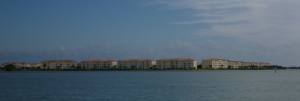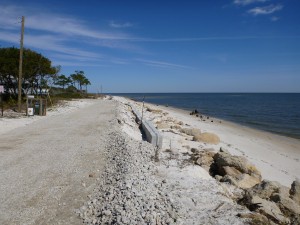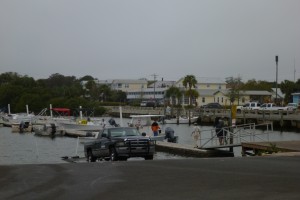The first step for a local government when considering sea-level rise or other coastal hazards is to assess the jurisdiction’s vulnerability. The scope and detail of this assessment may vary greatly depending on factors such as the type of hazard being considered, the size and complexity of the local government, and the staff and financial resources at the local government’s disposal for the vulnerability.
A first step in conducting a vulnerability assessment is to define the hazard. When addressing sea-level rise, defining specific scenarios or ranges of sea-level rise is becoming a standard practice for planning purposes (see, e.g. The United State Army Corps of Engineers’ Policy Guidance on Sea-Level Rise). A vulnerability assessment should, at a minimum, assess the likely impact of sea-level rise on critical infrastructure, including transportation infrastructure, power generation and supply, emergency response resources such as hospitals, fire stations, and police stations. With Florida’s low-lying geography in many coastal communities, assessment of the impact of sea-level rise on drainage systems is particularly important. Vulnerability assessments should also consider how potential inundation will affect the community and economy. This involves looking at the land uses and businesses potentially impacted as well as socioeconomic data of potentially impacted areas.
A vulnerability assessment should not be one-time event. Rather, maybe an initial, brief assessment will give rise to some policies and responses but will also generate questions that can only be answered by a more thorough assessment. Even for local governments with minimal staff and resources to dedicate to a vulnerability analysis, many existing resources can make development of a basic vulnerability analysis to sea-level rise a realistic endeavor. The following resources will assist local governments with understanding their vulnerability to sea-level rise.
National Institute of Standards and Technology’s “Community Resilience Planning Guide”
A new guide released by the National Institute of Standards and Technology (NIST) is now available to assist communities in evaluating the vulnerability of their infrastructure. However, the guide goes far beyond just looking at infrastructure from an engineering standpoint. In fact, a great strength of the approach taken by NIST is that their method begins with evaluation of the community and the people that comprise it–how the community really functions–as the starting point for helping the community understand how it uses infrastructure to service the community’s needs. Based on this understanding, communities can assess and more fully understand what infrastructure vulnerability really means to jobs, justice, safety, environment, entertainment, and services. This more robust understanding can give rise to greater community involvement in making decisions to prioritize addressing vulnerabilities.
Access to the NIST “Community Resilience Planning Guide”
Digital Coast Website of the National Oceanic and Atmospheric Administration
It is difficult to overstate the depth and utility of this website for local government efforts to address coastal hazards and increase resilience, especially for smaller local governments with staff and resource constraints that limit their ability to generate their own data and analyses. The site harbors four main areas under which resources reside: Data, Tools, Training, and “In Action.”
1. Data
This page provides dozens of data sets ranging from aerial photography to elevation data to economic data and many others. If the GIS and planning specialists in your local jurisdictions are not familiar with this site, they will enjoy the rich diversity of sources offered as well as links to many additional sources of data.
2. Tools
Now that you’ve got data, this page provides tools that assist in analyzing data and using it for decision making. Some tools that can be especially useful at the initial stages of vulnerability assessment for a small local government are:
- Sea Level Rise and Coastal Flooding Impacts Viewer–This internet-based viewer provides an easy-to-use interface permitting users to zoom into any part of Florida (and many other states) to view the extent of inundation resulting from sea-level rise ranging from 1 to 6 feet. The viewer even includes simulations of increased sea levels at local landmarks and overlays social and economic data to show the intersection of inundation with the most socially vulnerable areas.
- Coastal County Snapshots–These snapshots allow a user to focus on flood exposure, ocean jobs, or wetland benefits. Each snapshot then generates a short with charts and graphs based on relevant, national-level data sets.
- Sea Level Affecting Marshes Model (SLAMM)–A widely-used tool for examining the likely impacts of sea-level rise on the marsh systems.
- Digital Shoreline Analysis System–This provides software and guidance to utilize ArcGIS software to determine rate-of-change statistics from multiple historic shoreline positions. This can provide a useful tool for local governments to understand how their shorelines may be changing with current sea-level rise, erosion trends, and nourishment activities.
3. Training
The Training section provides information on training opportunities ranging from self-direct, online courses to on-site, instructor-led multi-day courses. Many of the trainings focus on topics related to understanding and use of GIS data. An excellent page here for beginning the vulnerability assessment process is the “Roadmap for Adapting to Coastal Risk,” which includes a three-hour virtual training.
4. In Action
An inter-active map where users can see examples of communities using the Digital Coast to address coastal issues.



